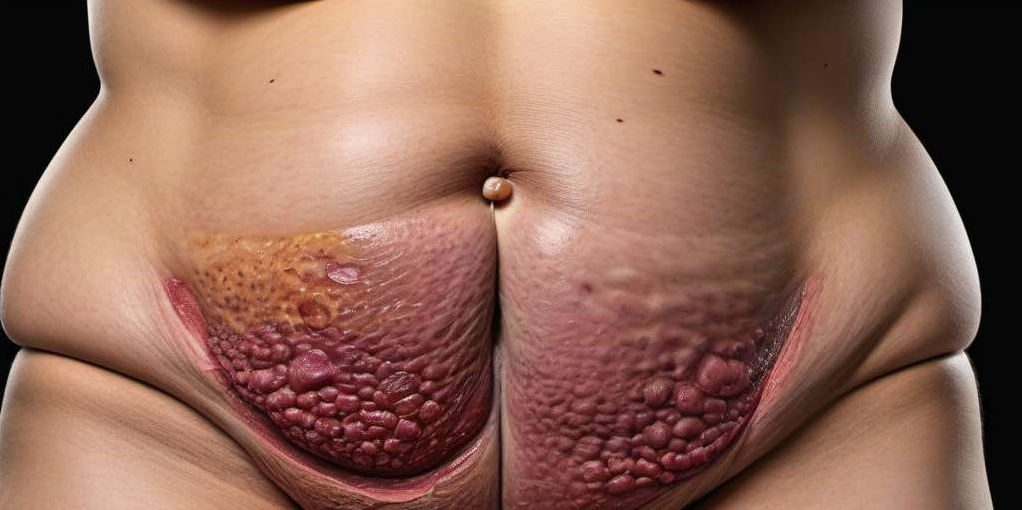
Understanding the complications of insulin injection sites is crucial in diabetes management. Lipohypertrophy, characterized by fatty tissue bumps under the skin, can impact insulin absorption and lead to serious issues. Rotating injection sites and using rapid-acting insulin are key preventive measures. Seeking professional guidance for treatment is essential in managing these complications effectively.
🔍 Seeking a breakthrough in Type 2 Diabetes management?
Discover our expert insights and innovative approaches on ‘How to Cure Diabetes’.
Click to transform your health journey today!
What you\'ll find in this article?
- Understanding Lipohypertrophy in Diabetes Management
- Types of Insulin Injections for Diabetes Treatment
- Recognizing and Managing Insulin Injection Sites Complications
- Preventive Measures for Healthy Insulin Injection Sites
- Addressing Hard Lump Formation on Skin Post-Injection
- Importance of Proper Insulin Dosage and Administration
- Lifestyle Changes to Support Diabetes Management
- Seeking Professional Help for Diabetes Treatment
- Educational Resources for Diabetes Patients
- Promoting Overall Health and Wellness with Diabetes Care
- Latest Research and Developments in Diabetes Treatment
Understanding Lipohypertrophy in Diabetes Management
Lipohypertrophy is a common condition in individuals with diabetes that involves the development of fatty tissue bumps beneath the skin. Understanding the causes, symptoms, risks, and complications associated with lipohypertrophy is crucial in diabetes management. This condition can impact insulin absorption and effectiveness, leading to potential challenges in treatment.
Causes and Symptoms of Lipohypertrophy
- Repetitive insulin injections in the same area
- Accumulation of fat and scar tissue
- Formation of hard lumps under the skin
- Skin redness and irritation
Risks and Complications Associated with Lipohypertrophy
- Reduced insulin absorption
- Increased blood sugar levels
- Potential for poor diabetes control
- Risk of complications such as hypoglycemia and hyperglycemia
Explore our specialized services in diabetes care 🌟.
From personalized diet plans to effective exercise routines, we have what you need to take control of Type 2 Diabetes.
Visit our services page now!








Types of Insulin Injections for Diabetes Treatment
Short-Acting vs. Long-Acting Insulin
When it comes to insulin injections for diabetes treatment, there are different types available, each with its own characteristics and uses. Short-acting insulin, also known as rapid-acting insulin, is designed to work quickly to lower blood sugar levels after meals. On the other hand, long-acting insulin provides a steady release of insulin over an extended period, helping to regulate blood sugar levels throughout the day.
Pen vs. Syringe Injections
Insulin injections can be administered using either insulin pens or syringes. Insulin pens are convenient and easy to use, with pre-filled cartridges that eliminate the need for drawing up insulin doses. Syringes, on the other hand, offer more flexibility in dose adjustments and are often preferred by those who require precise insulin dosing. Both methods have their advantages, and the choice between pens and syringes depends on individual preferences and needs.
Tips for Proper Insulin Injection Technique
- Ensure proper hand hygiene before administering insulin injections to prevent infections.
- Rotate injection sites to prevent lipohipertrophy and ensure consistent insulin absorption.
- Avoid injecting into areas with scar tissue or visible blood vessels.
- Follow the correct injection angle and depth as recommended by healthcare professionals.
- Store insulin properly to maintain its effectiveness and potency.
Recognizing and Managing Insulin Injection Sites Complications
Managing insulin injection sites complications is crucial in diabetes care. Recognizing and addressing issues promptly can prevent serious complications.
Importance of Rotating Injection Sites
Rotating injection sites helps prevent the development of lipohypertrophy, ensuring proper absorption of insulin throughout the body.
Signs and Symptoms of Complications
Hard Lump on Buttocks after Injection
- Pain or tenderness at the injection site
- Visible lumps or bumps under the skin
- Changes in insulin absorption rates
Consulting with Healthcare Professionals for Treatment
Seeking guidance from healthcare providers is essential for diagnosing and treating insulin injection sites complications effectively. Healthcare professionals can offer personalized treatment plans based on individual needs.
Preventive Measures for Healthy Insulin Injection Sites
When it comes to managing insulin injection sites, there are several preventive measures that can help ensure optimal health and well-being for individuals with diabetes.
Using New Needles for Each Injection
- Always use a new needle for each insulin injection to prevent contamination and reduce the risk of infection.
- Dispose of used needles in a proper sharps container to ensure safe handling and disposal.
- Rotate injection sites and change needles regularly to maintain healthy skin and prevent tissue damage.
Switching to Rapid-Acting Insulin Therapy
- Consider switching to rapid-acting insulin therapy for more precise blood sugar control and faster onset of action.
- Rapid-acting insulin can help reduce the risk of hyperglycemia and hypoglycemia by mimicking the body's natural insulin response.
- Consult with your healthcare provider about the benefits and potential side effects of rapid-acting insulin therapy.
Monitoring Blood Sugar Levels Effectively
- Regularly monitor your blood sugar levels to track changes and make informed decisions about insulin dosages.
- Use a blood glucose meter to measure your blood sugar levels at home and keep a log of your readings for reference.
- Consult with a diabetes educator or healthcare provider for guidance on interpreting blood sugar readings and adjusting insulin doses accordingly.
Addressing Hard Lump Formation on Skin Post-Injection
Causes of Hard Lump Formation
Hard lumps on the skin post-injection can be caused by repeated injection trauma, leading to tissue damage and accumulation of scar tissue. This can hinder insulin absorption and affect diabetes management.
Treatment Options for Hard Lumps
When addressing hard lump formation, various treatment options can be considered, including:
- Mild massage: Gently massaging the lump area can help disperse the accumulated tissue, promoting absorption of insulin.
- Warm compress: Applying a warm compress to the lump can help soften the tissue and reduce discomfort.
- Consulting a healthcare professional: Seeking advice from a healthcare provider is crucial to determine the best course of action for treatment.
- Avoiding injection site: Temporarily avoiding the affected injection site until the lump resolves can prevent further complications.
Importance of Proper Insulin Dosage and Administration
Proper insulin dosage and administration are crucial aspects of diabetes management to effectively control blood sugar levels and prevent complications. Understanding how insulin therapy influences blood sugar control and the impact of injection sites on insulin absorption is key to ensuring optimal treatment outcomes.
Effectiveness of Insulin Therapy on Blood Sugar Control
Insulin therapy plays a vital role in regulating blood sugar levels in individuals with diabetes. By mimicking the action of natural insulin in the body, exogenous insulin helps facilitate glucose uptake by cells for energy production. Proper dosage and timing of insulin administration are essential to maintain stable blood sugar levels throughout the day.
Factors such as diet, physical activity, stress, illness, and medication interactions can all influence the effectiveness of insulin therapy. Regular monitoring of blood sugar levels and adjusting insulin doses as needed are critical to achieving optimal glycemic control and reducing the risk of both hyperglycemia and hypoglycemia.
Impact of Injection Sites on Insulin Absorption
The choice of injection sites can significantly affect the rate and consistency of insulin absorption into the bloodstream. Different areas of the body can vary in the speed at which insulin is absorbed, with some sites absorbing insulin more rapidly than others. Rotating injection sites regularly helps prevent the development of lipohypertrophy and ensures consistent insulin absorption.
- Rotate injection sites to distribute the absorption rate evenly across different areas of the body.
- Avoid injecting into areas with scar tissue, as it can impede proper insulin absorption.
- Consult with a healthcare provider to determine the best injection sites based on individual needs and preferences.
Lifestyle Changes to Support Diabetes Management
In managing diabetes, incorporating lifestyle changes can have a significant impact on overall health and well-being. Lifestyle modifications encompass dietary adjustments, exercise routines, as well as mental health and stress management strategies to support optimal diabetes management.
Diet and Exercise Recommendations for Diabetic Patients
Proper nutrition plays a crucial role in managing blood sugar levels. Diabetic patients should focus on a balanced diet rich in whole foods, fruits, vegetables, lean proteins, and healthy fats. Incorporating regular physical activity, such as cardiovascular exercises, strength training, and flexibility exercises, can improve insulin sensitivity and promote overall health.
Mental Health and Stress Management Strategies
Mental health is an integral component of diabetes management. Adopting stress management techniques, such as mindfulness meditation, deep breathing exercises, yoga, or seeking professional counseling, can help reduce stress levels and enhance emotional well-being. Prioritizing self-care activities and engaging in hobbies or relaxation practices can also contribute to better mental health outcomes.
Seeking Professional Help for Diabetes Treatment
Regular Check-Ups and Monitoring of Diabetes Symptoms
Regular check-ups and monitoring of diabetes symptoms are crucial for effectively managing the condition. Healthcare professionals recommend scheduling routine visits to assess blood sugar levels, track any changes in symptoms, and adjust treatment plans accordingly.
Importance of Adhering to Medication Regimen
Adhering to a strict medication regimen is essential for controlling diabetes and preventing complications. It is important to follow the prescribed dosage and administration instructions provided by your healthcare provider to ensure optimal treatment outcomes.
Educational Resources for Diabetes Patients
When dealing with diabetes, accessing reliable and comprehensive information on effective management strategies is crucial for patients. Educational resources play a vital role in empowering individuals to take charge of their health and well-being.
Accessing Reliable Information on Diabetes Management
- Online Platforms: Websites and online portals dedicated to diabetes education provide a wealth of information on the latest treatment options, lifestyle recommendations, and technological advancements in diabetes care.
- Medical Journals: Peer-reviewed journals and publications offer in-depth insights into diabetes research, new therapies, and emerging trends in the management of the condition.
- Healthcare Providers: Consulting with healthcare professionals, including endocrinologists, diabetes educators, and nutritionists, can help patients access personalized information and guidance tailored to their specific needs.
Support Groups and Communities for Individuals with Diabetes
Support groups and community networks offer a valuable source of emotional support, practical advice, and shared experiences for individuals living with diabetes. Connecting with peers facing similar challenges can provide a sense of belonging and encouragement on the journey towards optimal diabetes management.
Promoting Overall Health and Wellness with Diabetes Care
When it comes to diabetes management, promoting overall health and wellness is essential for maintaining a balanced lifestyle. This approach involves incorporating various strategies to support physical, mental, and emotional well-being in individuals living with diabetes. Let's explore the holistic approach to diabetes management and the importance of self-care practices for improved quality of life.
Holistic Approach to Diabetes Management
- Focus on the whole person, considering physical, mental, and emotional aspects of health
- Encourage balance in diet, exercise, stress management, and overall lifestyle choices
- Promote individualized care plans that address the unique needs of each person with diabetes
Incorporating Self-Care Practices for Improved Quality of Life
Self-care plays a crucial role in enhancing the well-being of individuals with diabetes. By adopting positive habits and practices, individuals can better manage their condition and improve their quality of life. Here are some self-care practices that can make a difference:
- Regular physical activity, such as walking, biking, or swimming, to maintain healthy blood sugar levels and overall fitness
- Healthy eating habits, including a balanced diet rich in fruits, vegetables, whole grains, and lean proteins
- Stress management techniques like mindfulness meditation, yoga, deep breathing exercises, or engaging in hobbies and activities that bring joy and relaxation
- Regular monitoring of blood sugar levels to track progress and make informed decisions about diabetes management
Latest Research and Developments in Diabetes Treatment
The field of diabetes treatment is continually evolving with innovative therapies and technologies aimed at enhancing patient care and outcomes. As researchers delve deeper into understanding diabetes, promising advancements are being made to revolutionize diabetes management and improve the quality of life for individuals with the condition.
Innovative Therapies and Technologies for Diabetes Care
- Continuous Glucose Monitoring Systems: These devices offer real-time glucose monitoring, enabling individuals to track their blood sugar levels more effectively and make timely adjustments to their treatment plan.
- Artificial Pancreas Technology: Automated insulin delivery systems mimic the function of a healthy pancreas by regulating insulin dosing based on glucose levels, providing a more seamless and personalized approach to diabetes management.
- Insulin Pumps with Smart Algorithms: Advanced insulin pumps are equipped with intelligent algorithms that can predict and prevent hypoglycemic events, optimizing insulin delivery and minimizing the risk of dangerous blood sugar fluctuations.
Future Prospects in Diabetes Treatment and Management
Looking ahead, the future of diabetes treatment holds great promise with ongoing research and development initiatives that aim to transform the landscape of diabetes care. Here are some anticipated advancements on the horizon:
- Gene Therapy for Diabetes: Researchers are exploring gene-editing techniques that could potentially correct genetic abnormalities associated with diabetes, offering a potential cure or long-term disease management solution.
- Personalized Medicine Approaches: Tailored treatment plans based on genetic, lifestyle, and metabolic factors hold the key to optimizing diabetes care and achieving improved health outcomes for individuals with diabetes.
- Nanotechnology Applications: Nanomedicine holds the potential to revolutionize diabetes treatment through targeted drug delivery systems, implantable devices, and sensors that can enhance the precision and efficacy of diabetes management.
✨ Other articles you might be interested in:



